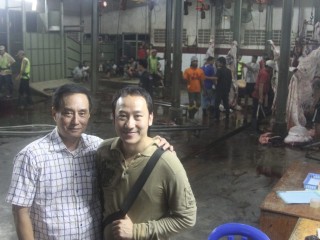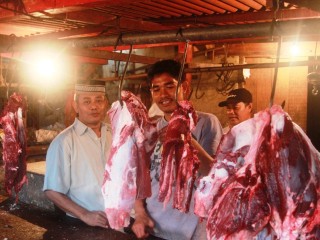 It is a steamy 1am on the outskirts of Jakarta and Budiman Lukman’s abattoir is abuzz with activity.
It is a steamy 1am on the outskirts of Jakarta and Budiman Lukman’s abattoir is abuzz with activity.
In just a few hours time the city’s wet markets will open for business, and butchers have converged on the small plant in their dozens to buy fresh meat for the new day’s trade.
About 40 cattle will be slaughtered within the next three hours, and the meat will be transported in scores of small utility trucks to hang in butcher’s stalls at nearby markets.
More than 80pc of the beef consumed in Indonesia is sold this way, traded within a few hours of slaughter direct to household consumers or bakso ball (meatball) makers.
In a country with a hot climate and little refrigeration, the wet market system enables consumers to buy and cook meat while it is still fresh and before it has time to spoil.
It is an efficient supply system that has barely changed for thousands of years, apart from one very notable exception.
Whereas once Pak Budiman’s small abattoir killed in the traditional manner, it and more than 60 like it now operate in accordance with the Australian Government’s Export Supply Chain Assurance System so they can receive Australian cattle.
Cattle now move from lairage pens through shielded races into an enclosed restraint box, where they are stunned and then slaughtered with a single cut to the throat as per Halal requirements.
Every animal movement is recorded by a race mounted RFID reader and instantaneously logged on the traceability system of Santori, the largest importer of cattle to Indonesia. The process is clean, fast and efficient.
Cattle stand quietly in covered lairage pens with food and water at the rear of the plant. There is none of the vocalisation, agitation or distress that was captured in footage from Indonesian abattoirs by Animals Australia or ABC Four Corners 12 months ago.
 Pak Budiman says the changes have cost a lot of money – “I think I try to forget the numbers, too long,” he says between laughs, when asked how much.
Pak Budiman says the changes have cost a lot of money – “I think I try to forget the numbers, too long,” he says between laughs, when asked how much.
But then his expression changes as he emphasises what the improvements have meant for his business.
“I am very appreciative of the system applied for animal welfare,” he said. “I feel I get the benefit”.
He explains that while the process has cost a lot of money, it has meant quieter cattle and in turn better quality meat, which has made his customers “very happy”.
Just as significantly, it has also generated serious savings in time and efficiency, which has also further helped his bottom line.
“Before we slaughter one head of cattle with the old system, it took I think about 40 minutes.
“Now only 5 to 10 minutes.”
Pak Budiman said the changes have taken a long time to implement, because many Indonesians were reluctant to change. However, he said that once they understood the benefits, they were fast to adopt the better practices.
• Keep an eye on Beef Central for more reports from Indonesia in coming days
